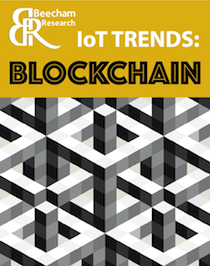Blockchain and its meaning for the IoT community

In the first of a new series of articles on emerging IoT trends by Beecham Research – Phill Pexton, senior analyst, and Saverio Romeo, principal analyst, with the firm examine blockchainMany people will be aware of Bitcoin, but only a few will be aware of the underlying technology that fuelled the rise of cryptocurrencies, namely, the blockchain. Simply put, a blockchain is an open distributed database of every transaction involving value.
Historically, when performing a transaction between two entities, the exchange of goods, services, etc. is handled and verified by a middleman. A blockchain transaction removes the middleman. Instead, this process of verification is carried out by some members of the network, called ‘miners’, who check the trade against all past records held within the network to ensure that what is being traded actually exists and is owned by the respective parties. This makes it very hard to simply create something out of mid-air.
Every few minutes the miner creates a verified file which holds a copied record of all transactions that have occurred in the network over the time frame, called a ‘block’, for which it charges a small fee. As each transaction in every block is made at a specific time, each block is linked to the previous block of transactions. By grouping these blocks we get what is referred to as the blockchain. And since this grouping of blocks occurs as per the protocol dictated by the algorithm underpinning the creation of Bitcoins, this protocol is defined as the blockchain protocol. The mathematics involved is extremely complex, and the use of specialised hardware to construct this vast chain of cryptographic data renders it practically impossible to replicate.
Large market players are looking at blockchain
This importance of this technology is its ability to decentralise trust. Instead of trusting wholly in a middle entity, which is potentially corruptible and adds an additional link privy to sensitive information that attackers can target, a blockchain relies on the unscrupulous party having to justify an action to the majority of, if not all, other parties in the public domain, which proves incredibly costly in both time and money. If the currency can be arbitrarily allocated to anything of value, therefore, the technology could be used for authentication, digital signage, development of smart contracts, or numerous other possibilities. That is why it has received considerable attention from the likes of IBM, Microsoft, Dell, Bosch, Samsung, and the R3 consortium – a consortium of 42 financial companies including Barclays, JPMorgan, Santander and Wells Fargo.
IoT and blockchain
One example of using a different cryptocurrency, is the Ethereum platform, which provides a decentralised virtual machine that can execute peer-to-peer contracts using a crypto asset called ‘Ether’. But there are many more, including TauChain and Maidsafe. Ethereum, however, forms the basis of the IBM ADEPT (Autonomous Decentralised Peer-to-Peer Telemetry) system for the Internet of Things, developed alongside Samsung. It is also the basis of Ethcore, a private venture focused on IoT.
For IoT, the technology allows developers a simple way of outsourcing security. For example, instead of having to create secure IoT devices and networks, much of the heavy lifting could be effectively offloaded to the blockchain, becoming an additional security layer whilst freeing up resources on the client’s side and speeding up development. Ultimately, the shared goal for the technology is to make it just as seamless and unobtrusive as internet protocols. In much the same way TCP/IP allows information to be transmitted instantly today, the blockchain protocol allows the instant transfer of value irrespective of size.